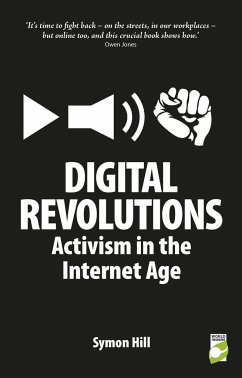Symon Hill
Digital Revolutions: Activism in the Internet Age
16,99 €
inkl. MwSt.
Versandfertig in über 4 Wochen

8 °P sammeln
Symon Hill
Digital Revolutions: Activism in the Internet Age
- Broschiertes Buch
- Merkliste
- Auf die Merkliste
- Bewerten Bewerten
- Teilen
- Produkt teilen
- Produkterinnerung
- Produkterinnerung
From Occupy to the Arab Spring: how the Internet and social media are changing activism and movements.
Andere Kunden interessierten sich auch für
![Atrocity Exhibition: Life in the Age of Total Violence Atrocity Exhibition: Life in the Age of Total Violence]() Brad EvansAtrocity Exhibition: Life in the Age of Total Violence16,99 €
Brad EvansAtrocity Exhibition: Life in the Age of Total Violence16,99 €![It Did Happen Here It Did Happen Here]() Milan ZafirovskiIt Did Happen Here54,99 €
Milan ZafirovskiIt Did Happen Here54,99 €![The Globalization of NATO The Globalization of NATO]() Mahdi Darius NazemroayaThe Globalization of NATO23,99 €
Mahdi Darius NazemroayaThe Globalization of NATO23,99 €![Objective Troy: A Terrorist, a President, and the Rise of the Drone Objective Troy: A Terrorist, a President, and the Rise of the Drone]() Scott ShaneObjective Troy: A Terrorist, a President, and the Rise of the Drone16,99 €
Scott ShaneObjective Troy: A Terrorist, a President, and the Rise of the Drone16,99 €![The British Cruise Ship an Illustrated History 1945-2014 The British Cruise Ship an Illustrated History 1945-2014]() Ian CollardThe British Cruise Ship an Illustrated History 1945-201431,99 €
Ian CollardThe British Cruise Ship an Illustrated History 1945-201431,99 €![The Black Ledger: How Trump Brought Putin's Disinformation War to America The Black Ledger: How Trump Brought Putin's Disinformation War to America]() Robert WaldeckThe Black Ledger: How Trump Brought Putin's Disinformation War to America23,99 €
Robert WaldeckThe Black Ledger: How Trump Brought Putin's Disinformation War to America23,99 €![The Modern Historian: The US Financial Crisis of 2008 The Modern Historian: The US Financial Crisis of 2008]() D. M. AlonThe Modern Historian: The US Financial Crisis of 200810,99 €
D. M. AlonThe Modern Historian: The US Financial Crisis of 200810,99 €-
-
-
From Occupy to the Arab Spring: how the Internet and social media are changing activism and movements.
Hinweis: Dieser Artikel kann nur an eine deutsche Lieferadresse ausgeliefert werden.
Hinweis: Dieser Artikel kann nur an eine deutsche Lieferadresse ausgeliefert werden.
Produktdetails
- Produktdetails
- Verlag: New Internationalist
- Seitenzahl: 160
- Erscheinungstermin: 14. Mai 2013
- Englisch
- Abmessung: 216mm x 136mm x 15mm
- Gewicht: 221g
- ISBN-13: 9781780260761
- ISBN-10: 1780260768
- Artikelnr.: 36627417
- Herstellerkennzeichnung
- Libri GmbH
- Europaallee 1
- 36244 Bad Hersfeld
- gpsr@libri.de
- Verlag: New Internationalist
- Seitenzahl: 160
- Erscheinungstermin: 14. Mai 2013
- Englisch
- Abmessung: 216mm x 136mm x 15mm
- Gewicht: 221g
- ISBN-13: 9781780260761
- ISBN-10: 1780260768
- Artikelnr.: 36627417
- Herstellerkennzeichnung
- Libri GmbH
- Europaallee 1
- 36244 Bad Hersfeld
- gpsr@libri.de
Symon Hill has been an activist since his teens. He has campaigned on issues including the arms trade, religious liberty, same-sex marriage, disability rights and economic injustice. He has worked with NGOs including the Campaign Against Arms Trade, People & Planet and the Fellowship of Reconciliation and was a founding member of Christianity Uncut. He has trained hundreds of grassroots activists in campaigning skills and media engagement. In February 2012, he was dragged by police from the steps of St Paul's Cathedral during the eviction of Occupy London Stock Exchange. He is associate director of the Ekklesia thinktank and an associate tutor at the Woodbrooke Quaker Study Centre. He writes regularly for the Guardian, Morning Star, The Friend and Third Way. His first book was the No-Nonsense Guide to Religion.
1. Foreword by Peter Tatchell.
2. Introduction.
3. The 'menace' of cyberspace.
Social media and other communication technologies have been a feature
of recent protest movements. The mainstream media moved from ignoring
them altogether to presenting them as revolutionary. But just how
central has the internet been to recent resistance?
4. Breaking the monopoly.
2009: in Iran and Britain two individual deaths are transformed by
social media into events of massive political significance. And both
governments and media barons realize the game has changed.
5. The hashtag revolution.
The Uncut movement against tax-dodging that went viral. The Slutwalks
that became a global phenomenon. Two very different forms of protest
that took off thanks in part to a simple Twitter device called the
hashtag.
6. 'We are next!'
Catalyst or tool? What part did the internet play in the cascading
revolutions and rebellions that became known as the Arab Spring or
Arab Awakening?
7. Camping on the doorsteps of power.
From Climate Camps to Tahrir Square, from Indignados to Occupy, the
humble tent has become a vital accessory to modern resistance
movements. But just as integral to these protests has been
cutting-edge communications technology - and their success may lie in
the creative tension between online and physical space.
8. Cyberactivism explodes.
From mass online petitions by the likes of Avaaz and 38 Degrees to
YouTube protests like Pussy Riot, cyberactivism is breaking new
ground. But even as it takes us into virgin territory, it throws up
important new questions - not least about the value of 'clicktivism'
and about the impact of the internet on minority languages.
9. Fighting corporations in cyberspace.
The new communications technology may be used by protesters - but all
the tricks of the trade are of course also available to transnational
corporations and governments. 'Astroturfers' are infesting online
debates, emails are being harvested and websites are being shut down.
Battle in the ether has well and truly been joined.
10. These hands our weapons.
Cyberactivism is not a magical cure-all - it is a tool like any other
that can be put to good use or bad. But it is impossible to ignore -
and much about our collective
future will depend on how we harness the power of the internet to
inspire resistance.
11. Bibliography.
2. Introduction.
3. The 'menace' of cyberspace.
Social media and other communication technologies have been a feature
of recent protest movements. The mainstream media moved from ignoring
them altogether to presenting them as revolutionary. But just how
central has the internet been to recent resistance?
4. Breaking the monopoly.
2009: in Iran and Britain two individual deaths are transformed by
social media into events of massive political significance. And both
governments and media barons realize the game has changed.
5. The hashtag revolution.
The Uncut movement against tax-dodging that went viral. The Slutwalks
that became a global phenomenon. Two very different forms of protest
that took off thanks in part to a simple Twitter device called the
hashtag.
6. 'We are next!'
Catalyst or tool? What part did the internet play in the cascading
revolutions and rebellions that became known as the Arab Spring or
Arab Awakening?
7. Camping on the doorsteps of power.
From Climate Camps to Tahrir Square, from Indignados to Occupy, the
humble tent has become a vital accessory to modern resistance
movements. But just as integral to these protests has been
cutting-edge communications technology - and their success may lie in
the creative tension between online and physical space.
8. Cyberactivism explodes.
From mass online petitions by the likes of Avaaz and 38 Degrees to
YouTube protests like Pussy Riot, cyberactivism is breaking new
ground. But even as it takes us into virgin territory, it throws up
important new questions - not least about the value of 'clicktivism'
and about the impact of the internet on minority languages.
9. Fighting corporations in cyberspace.
The new communications technology may be used by protesters - but all
the tricks of the trade are of course also available to transnational
corporations and governments. 'Astroturfers' are infesting online
debates, emails are being harvested and websites are being shut down.
Battle in the ether has well and truly been joined.
10. These hands our weapons.
Cyberactivism is not a magical cure-all - it is a tool like any other
that can be put to good use or bad. But it is impossible to ignore -
and much about our collective
future will depend on how we harness the power of the internet to
inspire resistance.
11. Bibliography.
1. Foreword by Peter Tatchell.
2. Introduction.
3. The 'menace' of cyberspace.
Social media and other communication technologies have been a feature
of recent protest movements. The mainstream media moved from ignoring
them altogether to presenting them as revolutionary. But just how
central has the internet been to recent resistance?
4. Breaking the monopoly.
2009: in Iran and Britain two individual deaths are transformed by
social media into events of massive political significance. And both
governments and media barons realize the game has changed.
5. The hashtag revolution.
The Uncut movement against tax-dodging that went viral. The Slutwalks
that became a global phenomenon. Two very different forms of protest
that took off thanks in part to a simple Twitter device called the
hashtag.
6. 'We are next!'
Catalyst or tool? What part did the internet play in the cascading
revolutions and rebellions that became known as the Arab Spring or
Arab Awakening?
7. Camping on the doorsteps of power.
From Climate Camps to Tahrir Square, from Indignados to Occupy, the
humble tent has become a vital accessory to modern resistance
movements. But just as integral to these protests has been
cutting-edge communications technology - and their success may lie in
the creative tension between online and physical space.
8. Cyberactivism explodes.
From mass online petitions by the likes of Avaaz and 38 Degrees to
YouTube protests like Pussy Riot, cyberactivism is breaking new
ground. But even as it takes us into virgin territory, it throws up
important new questions - not least about the value of 'clicktivism'
and about the impact of the internet on minority languages.
9. Fighting corporations in cyberspace.
The new communications technology may be used by protesters - but all
the tricks of the trade are of course also available to transnational
corporations and governments. 'Astroturfers' are infesting online
debates, emails are being harvested and websites are being shut down.
Battle in the ether has well and truly been joined.
10. These hands our weapons.
Cyberactivism is not a magical cure-all - it is a tool like any other
that can be put to good use or bad. But it is impossible to ignore -
and much about our collective
future will depend on how we harness the power of the internet to
inspire resistance.
11. Bibliography.
2. Introduction.
3. The 'menace' of cyberspace.
Social media and other communication technologies have been a feature
of recent protest movements. The mainstream media moved from ignoring
them altogether to presenting them as revolutionary. But just how
central has the internet been to recent resistance?
4. Breaking the monopoly.
2009: in Iran and Britain two individual deaths are transformed by
social media into events of massive political significance. And both
governments and media barons realize the game has changed.
5. The hashtag revolution.
The Uncut movement against tax-dodging that went viral. The Slutwalks
that became a global phenomenon. Two very different forms of protest
that took off thanks in part to a simple Twitter device called the
hashtag.
6. 'We are next!'
Catalyst or tool? What part did the internet play in the cascading
revolutions and rebellions that became known as the Arab Spring or
Arab Awakening?
7. Camping on the doorsteps of power.
From Climate Camps to Tahrir Square, from Indignados to Occupy, the
humble tent has become a vital accessory to modern resistance
movements. But just as integral to these protests has been
cutting-edge communications technology - and their success may lie in
the creative tension between online and physical space.
8. Cyberactivism explodes.
From mass online petitions by the likes of Avaaz and 38 Degrees to
YouTube protests like Pussy Riot, cyberactivism is breaking new
ground. But even as it takes us into virgin territory, it throws up
important new questions - not least about the value of 'clicktivism'
and about the impact of the internet on minority languages.
9. Fighting corporations in cyberspace.
The new communications technology may be used by protesters - but all
the tricks of the trade are of course also available to transnational
corporations and governments. 'Astroturfers' are infesting online
debates, emails are being harvested and websites are being shut down.
Battle in the ether has well and truly been joined.
10. These hands our weapons.
Cyberactivism is not a magical cure-all - it is a tool like any other
that can be put to good use or bad. But it is impossible to ignore -
and much about our collective
future will depend on how we harness the power of the internet to
inspire resistance.
11. Bibliography.







